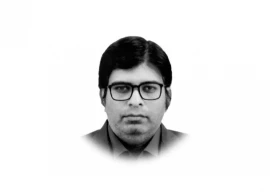
Funerals are the only constant for Zoroastrians in Pakistan. For a community of less than 1,800 — last recorded in 2006 in a research conducted by KE Eduljee — the announcement comes faithfully almost once every month. The timings are noted in chalk on a designated blackboard — one in almost every colony — and those who read it first pass on the information to others. The news of birth, on the other hand, comes with an element of surprise.
At the 10th World Zoroastrian Congress held in Mumbai in 2013, it was announced that the global population of Zoroastrians was less than 140,000, one-third of whom are aged above 60.
India, home to the largest Parsi population (Zoroastrians who fled to Iran in the seventh century AD after Muslims rose to power) has witnessed a decline from 114,000 Parsis in 1941 to 69,001 in 2001, according to their last fully published census.
Following this trend, the 2013 birth-and-death ratio among Indian Parsis was 735 deaths compared to an abysmal 174 births. While the decline in population has not been documented in Pakistan, evidence of shrinking numbers is indisputable.
The Saddar area in Karachi, which was once dotted with tea shops, bakeries and restaurants run by Zoroastrians, is now a shadow of the legacy many have left behind.
Even Parsi stalwarts, including the likes of Karachi’s first mayor Jamshed Nusserwanji Rustomji Mehta and the widely revered Ardeshir Cowasjee, who were once visible on the societal forefront, participating in politics and making notable contributions to cultural discourse, have gradually faded away.
To prevent the decline of possibly the world’s smallest religious community, in 1999 Unesco initiated the PARZOR (Parsi-Zoroastrian) project in India. This was to create awareness regarding dwindling numbers and to revive interest for the cause within the community, country and globally. The project has since become a catalyst for change with its biggest success being the launch of the Jiyo Parsi scheme in 2013.
An initiative of the Indian government, backed by the PARZOR Foundation and Bombay Parsi Panchayat, the programme primarily targets the community’s married couples, encouraging them to procreate, and provides financial support for fertility treatment, if needed. For families with an annual income of INR1,000,000 and below, the government has assured 100% financial assistance, which is slashed to half for families whose income falls within the bracket of INR1,500,000 to INR2,000,000. In total, a sum of INR100 million will be spent over a period of four years.
With India’s Parsi population expected to drop to 20,000 by 2020, this scheme might be the only road to recovery. Backed by seven-year research conducted by the PARZOR Foundation and the Tata Institute of Social Sciences — which identified late marriages, a growing number of unwed Parsis and low fertility as the primary causes of decline — it launched its tongue-in-cheek print campaign this month.
Although the ads which prod single men and women with messages such as ‘it’s time you broke up with your mother’ and urges couples to ‘be responsible, don’t use a condom tonight’, have been met with mixed response, the scheme has already proven successful with the delivery of a pair of twins and two baby girls. Over the course of six years, it is expected to facilitate an additional 200 births.
While the Indian government has taken a step to pay their debt to the Indian Parsis, the Pakistan government — still struggling to give its minorities their basic rights — has entirely sidelined the Zoroastrian population. The extent of neglect is visible from the exclusion of Zoroastrians from demographic studies conducted by the National Institute of Population Studies in Islamabad. The only time the community suddenly crosses the mind is when it’s time to vote or participate in a dharna.
So far, no attempt has been made to preserve Zoroastrian culture by either engaging in sustainable research and documentation or initiating a scheme like Jiyo Parsi.
While the community has always extended a hand for support and been a shoulder to lean on, be it through opening the doors of Karachi’s Mama Parsi Girls’ High School and Bai Virbaijee Soparivala Parsi High School for all, to donating Jahangir Park and Kothari Parade Clifton and establishing the charitable Eduljee Dinshaw Dispensary, it has now become the victim of a one-way relationship.
Grappling with the threat of imminent extinction, the community has been forced to consider unorthodox solutions. In a desperate attempt to bring about instant change there have even been talks of reversing the non-proselytising rule in Karachi.
Each successive year, the Papeti mela held at Beach Luxury, Karachi, is a stark reminder of the waning community. The Karachi Parsi Institute which hosted annual sports events, including swimming galas, cricket, football and badminton tournaments and a special ‘hungama’ event for Navroze, where teams of four would compete against each other in a series of races, now struggles with a shortage of participants. The community has long moved past the stage of denial and many say that it is now time the government and Zarthostis collaborate to put two and two together and come up with a formula to revive the population in Pakistan.
But this is easier said than done since many in the community are not in favour of such drastic steps. They prefer to stay away from the limelight — even if that means slowly fading away with time.
Published in The Express Tribune, November 29th, 2014.


















COMMENTS
Comments are moderated and generally will be posted if they are on-topic and not abusive.
For more information, please see our Comments FAQ